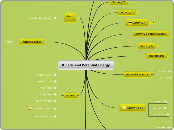Created by: Molly Smidovec, Savana Jimenez, Xue Wang, & Jessica Meza
Concept Map - Cell
Energy
Flow of energy
Photosynthesis
Phase 3:Regeneration of the CO2 acceptor (RuBP)
Phase 2: Reduction
The 5 other molecules of 3 Carbons go through the cycle
1 molecule of 3 Carbons goes on and forms glucose and other organic compounds
Phase 1: Carbon fixation
Light Reactions
Water splits
Release Oxygen
Produce ATP
Form NADPH
Photosystem II
Pq
Cytochrome complex
Pc
Fd
NADP+ reductase
NADPH to Calvin Cycle
Respiration
Anaerobic (fermentation)
Lactic Acid Fermentation
2 Lactate formed
prokaryotes
Alcohol Fermentation
2 ethanol formed
glycolysis
2 atp and pyruvate end product
Aerobic
eukaryotes
Requires activation energy
Redox Reaction
Reduction gain electron
Oxidized lose electrons
enzyme
Allosteric
Cooperativitiy
Inhibition
Activation
Feedback inhibition
Specific Temperature and pH
Substrate level
metabolic pathway
Endergonic
Exergonic
Anabolic
Catabolic
Kinetic energy and potential energy
Potential Energy
Kinetic Energy
The energy of motion
Laws of Thermoynamics
2nd Law
When energy changes from one form to another, entropy increases
1st Law
Energy cannot be created nor destroyed
Genetics
Regulation
Heterochromatin
highly compacted
no genes expressed
Euchromatin
less compaction
genes expressed
Packaging
B DNA Helix- 2 nm
Nucleosomes- 10 nm
Tight Helical Fiber-30 nm
Protein Scaffold (looped domains)- 300 nm
Metaphase Chromosome- 700 nm
Cell communiation
Physical Contact
Releasing a signal
Synaptic Signaling
Neurotransmitters
Paracrine Signaling
Translation (occurs in cytoplasm)
A site
Protein coded
P site
E site
Met
F-met
Transcription
termination
Poly-a tail
5-Cap
elongation
elongate transcription
initiation
Prokaryotes (occurs in cytoplasm)
RNAP
Eukaryotes (occurs in nucleus)
RNA Pol III
tRNA
5S rRNA
RNA Pol II
preMRNA
snRNA
microRNA
RNA Pol I
rRNA
Replication
Prokaryotes-cytoplasm
Helicase
SSB
topoisomerase
Primase
DNA pol III
DNA pol I
DNA ligase
Eukaryotes-nucleus
Structure Fits Function
Molecules and macromolecules
Lipids
Micelles
help in drug delivery
Phospholipids
amphipathic
2 fatty acids
glycerol
Phosphate
used in cell membrane
Intergral protein
G-Protein receptor
Sodium-Potassium transport
Receptor tyrosine kinase
Saturated Fats
excess H
Unsaturated Fats
Cis
Has a kink
Hydrogens on same side
less H
Trans
Hydrogens on opposite side
Steroids
Cholesterol
increase fluidity in cold
rigid in hot temperature
Testosterone
Proteins
Structures
Alpha helices
Beta pleated sheets
Disulfide bond
Primary structure: sequence of amino acids
Secondary structures: hydrogen bonds between alpha helices or beta pleated sheets
Tertiary structure: bonds in protein folding, disulfide, hydrogen, ionic, Van der Waals
Quaternary structure: Structure maintained by interchain interactions
Denaturation
Active to inactive: unfolding of a protein structure from heat or chemical reaction
Amino Acids
20 Amino acids
Polar
Threonine
Tyrosine
Glutamine
Asparagine
Cysteine
Serine
Acidic
Glutamic acid
Aspartic acid
Basic
Lysine
Histidine
Arginine
Nonpolar
Glycine
Leucine
Isoleucine
Tryptophan
Proline
Phenylalanine
Methionine
Valine
Alanine
Main chain
Carboxyl Group
Amino group
Side chain
Carbohydrates
Polysaccharides
Synthesis and breakdown of polymers
Hydrolysis
Adds a water to break a bond
Condensation (dehydration) reactions
Removes a water molecule and forms a new bond
Form fits function
Strarch
Energy storage in plants: unbranched helix
Cellulose
Used for structural support in cell walls of plants and algae: parallel strands joined by hydrogen bonds
Glycogen
Used for energy storage in animal cells: highly branched helix
DNA and RNA structure
RNA
Ribose suger: pentose
Nucleotide
Uracil
DNA
Nucleotides
Thymine
Guanine
Adenine
Cytosine
Deoxyribose: hexose sugar
Bonds
Covalent
Sharing of electron pairs
Ionic
Attraction of opposite charges
Hydrophobic Interaction
Interaction of nonpolar substances in the presence of polar substances
Van der Waals Interaction
Interaction of electrons of nonpolar substances
Hydrogen
Sharing of H atom
The Three Domains of Life
Domain Eukarya
Eukaryotes
Plant cells
Plant Cell Structures
secretory pathway
detoxification
sent out of cell
Secretory pathway
Cytosol
Medium for suspension
Vacuoles
Stores large amounts of liquid
Turgid at normal level
Chloroplasts
Capture light and makes food for the plant
Calvin Cycle
Light reaction
Plastids
Carry out photosynthesis
Cell membrane
Structural support and prevents plant from bursting
Some secondary walls with lignin
Animal Cells
Animal Cell Structures
Nucleopore
tiny holes in the nuclear membrane that allow transport of nucleic acids and proteins
Nucleolus
within nucleus and helps in synthesis of ribosomes
Protein synthesis happens here
Mitochondria
Most energy is released by respiration here
microtubules
hollow rods, function primarily as support and shape to the cell
protein tranport
Lysosomes
enzyme sacs, that digest cellular wastes.
Golgi
responsible for storing, packaging of cellular products.
ER
Rough
with ribosomes
Smooth
without ribosomes
Nucleus
Contains genetic material, which controls the activities of the cell
Cytoplasm
Most chemical processes take place here, controlled by enzymes
Cell Membrane
Controls the movement of substances into and out of the cell
Domain Archaea
Bacteria
Domain Bacteria
Bacterial Cell Structures
cytoplasm
peptidoglycan
rigid mechanical support
Endospore
Remain viable in harsh conditions
Periplasmic space
contains hydrolytic enzymes
& binding proteins
Inclusion Bodies
storage of carbon, phosphate
& other substances
Nucleoid
localization of DNA
Fimbriae & Pili
attachment to surfaces
bacterial mating
Flagella
movement
Ribosomes
protein synthesis
Plasmid
Gas Vacuole
buoyancy for floating
Plasma Membrane
Selectively permeable
nutrient and waste transport
Cell Wall
gives shape & protection
Capsules
resistance to phagocytosis
Prokaryotes
Uses operons









